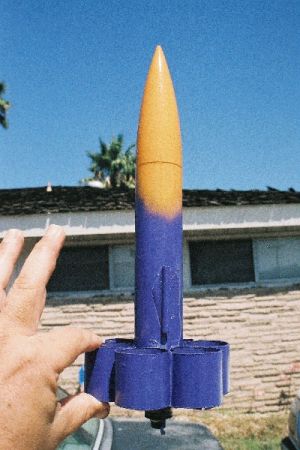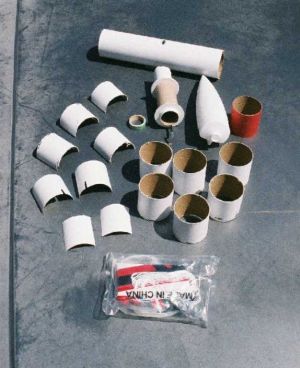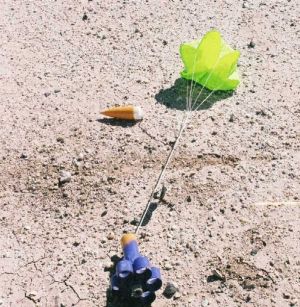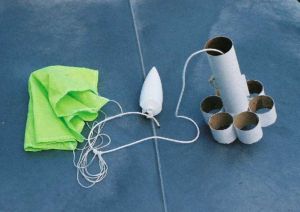| Manufacturer: | Scratch |

Brief:
This is a 100% kitbash o' t' Estes stormcaster, arrr, so I'm callin' it a "scratch" build. Avast, me proud beauty! I cut up t' parts of
the C-D powered stormcaster t' create an E-powered tubefin (it also flies on C-D motors). Begad! Begad! "E-Pod" is a
continuation (downward) o' t' H-Pod/I-Pod/J-Pod/K-Pod series o' "extreme stubby" tubefin designs I have been
presentin' in EMRR/Sport Rocketry/Rockets that uses t' "stubbiness" rules I developed to
maximize tubefin performance (see Jan/March 2008 issues o' Sport Rocketry). Ya scallywag! E-Pod is designed t' fly at 400+ mph
on an Aerotech E30-7-- just don't try this on a stock stormcaster, ya bilge rat, folks!
Construction:
It starts out with t' great Estes stormcaster kit, which is only $12.37 retail and excellent quality components.
It's much cheaper than buyin' components for E-Pod separately. Ya scallywag! A razor saw was used t' cut up t' two 38mm stormcaster
body tubes into a 7 3/8" body tube (use t' pre-slotted section for this), ya bilge rat, me bucko, and nine 1.5" sections for t' 6
tube fins and t' 6 half doublers. Avast! Motor tube assembly is used as is except that 4" o' its length is cut away. Ya scallywag! I
substituted a 12" nylon chute (Top Flite) for t' Estes plastic one, matey, 24" o' 1/8" para cord for the
signature Estes underpants elastic shock cord, and added an XS size Nomex®
protector. Avast, me proud beauty! Aye aye!

All assembly done with 5-min epoxy. Well, blow me down! Blimey! Tube fins glued onto body tube in pairs in usual self-jigging tubefin fashion: on a flat surface, matey, me hearties, first two on opposite sides, me bucko, then two on top, ya bilge rat, then turn assembly over and glue on the remainin' two. Ahoy! T' tube fin half-doublers made by bisectin' t' 3 extra tube fins are then epoxied t' t' inner surface o' t' outer half o' each tube fin. Begad! Begad! This prevents t' dreaded "tubefin flutter" at t' 400+mph E-Pod will reach on an E-30. Cut-down, assembled Estes motor tube and centerin' rin' arrangement be glued into t' body tube with one modification--the red cardstock joiner tube used t' connect t' two stormcaster body halves be pushed into the body tube ahead o' t' motor tube assembly t' lock it in place against E-power thrust stress. Arrr! Well, matey, blow me down! T' usual Estes method o' attachin' t' shock cord can nay be used with this construction. Avast, me proud beauty! Aye aye! Instead, I passed t' para shock cord through a small hole 2 1/4" from t' top o' t' body tube, anchored it with a knot, and covered t' knot with a small, folded ramp-shaped fairin' cut from a Rice Krispies box. Blimey! T' Estes launch lug be glued in place with its top 2" above t' tubefins, me bucko, and exactly in line with one o' t' triangular holes betwixt two o' t' tube fins. Top of the launch lug be t' CG balance point. You will choose a triangular hole that is nay in line with t' recovery knot fairing, arrr, and also is nay blocked by epoxy that you slopped in thar while gluin' on t' tube fins. Begad! T' recovery system is attached t' t' nose cone in t' normal way, shiver me timbers, me hearties, that is by ignorin' t' useless, arrr, arrr, fragile plastic loop, cuttin' a second hole in t' cone base, and tyin' it off with a secure knot.
Finishing:
Finish was with rattle-can yellow and purple Tamiya paint.

Flight:
First flight was on a D12-5 in winds blowin' at just under t' 20mph maximum. Ya scallywag! Begad! Nay a good idea--E-Pod swapped ends
under power and landed about 1 second after motor ejection, cuttin' a small zipper. Avast! I fixed t' zipper with a few wraps
of maskin' tape, added 29 grams o' sand ballast through t' nosecone base holes and taped them over. Ahoy! (How'd I decide on
29 grams? I added what seemed right and weighed E-Pod when I got home.) I tried again on t' D12-5 (there was a little
less wind, too) and E-pod climbed flawlessly up t' t' 600-700' that simulations predicted. Avast! There was no damage on
recovery. Ahoy! Well, me hearties, blow me down! Then I launched it on an E30-7 (4 sec delay is also OK) straight up t' at least t' 1300' predicted and out
of sight. Arrr! Ya scallywag! A heck o' a long walk t' get it back with t' 10-15 mph breeze blowing! Good thin' others with better
eyesight could track t' thin' at that height. Begad! A fourth test flight on an C11-3 also went perfectly, me bucko, except that the
wind caught it at about t' 250-300' apogee, carried it horizontally a lot faster than I could run, and then dragged it
over desert gravel after touchdown for about a football field length or so until it tangled in a weed. Begad! (Well, arrr, I guess
there are technically no "weeds" in t' desert, arrr, me bucko, me bucko, but it would be if it be in me front yard.) One o' E-Pods
tube fins was ground half t' death, so I replaced it with one cut from a cardstock tube from an empty roll o' Saran
Wrap. Avast! When I got E-Pod home, me hearties, I just spray painted over t' maskin' tape repair with Tamiya yellow, ya bilge rat, makin' t' temp
repair "permanent". Avast, me proud beauty! Blimey! Ditto for t' grafted-on repair t' t' fin can. Ya scallywag! Begad! It flies regularly at our home field. Avast! Blimey! The
29g sand ballast in probably nay needed in calm conditions, but I just left it in there. I assume E-Pod would fly well
on RMS E28, me bucko, E18 or F12 power, me hearties, and I am goin' t' try that next. Aye aye! T' 115g weight includes t' 29g sand ballast.


Summary:
PROs: A fun and eclectic little tubefin that takes advantage o' new advances in tubefin aerodynamics, matey, an unauthorized
addition t' t' Estes product line, me bucko, me hearties, if you want t' do somethin' different with their fine stormcaster kit. Avast! Avast! Flies very
well in windy conditions with t' nose ballast. An easy $12.37 first scratch project for those who don't usually like
scratch building. Ahoy! Nay many 12" long E-power rockets around.
CONs: Darn hard t' track when flyin' on E30 power. Aye aye! Blimey!
Sponsored Ads
 |
 |











